


Notice: This is the official website of the All Empires History Community (Reg. 10 Feb 2002)
Amerindian cavalries |
Post Reply 
|
Page 12> |
| Author | |
Guests 
Guest 
|
 Quote Quote  Reply Reply
 Topic: Amerindian cavalries Topic: Amerindian cavalriesPosted: 06-Mar-2008 at 23:53 |
|
From the Far West movies, we are accustumed to imagine Native Americans riding horses. Here is the image we have in mind of the Sioux, Apache and other North American tribes, attacking the colones.
Sioux
  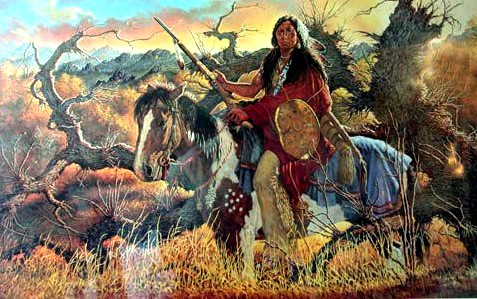   Comanches
  Apaches
 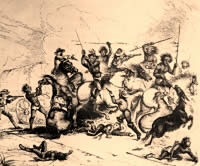  Well, the idea of this thread is to show all the Amerindian cavalries of the Western Hemisphere. There are many. I will post a couple and let's hope you help me in this colection.
Edited by pinguin - 08-Mar-2008 at 00:34 |
|
 |
|
Guests 
Guest 
|
 Quote Quote  Reply Reply
 Posted: 07-Mar-2008 at 00:19 Posted: 07-Mar-2008 at 00:19 |
|
From Brazil, copied from another forum:
Guaykuru Horsemen Warriors, by Jean Baptiste Debret  The Guaykurus was the first indigenous of all Americas to tame the wild horse (spanish horses abandoned in Chaco region). With war cavalry, they got powerful and aristocratics, had other tribes as vassals and slaves. Guaykurus had problems in alliance with Portugueses, but they battled for Brazil in THE GREAT PATRIOTIC WAR against Paraguai(1864-1860). The Kadiweus are a direct ramification and descendants of originals Guaykurus Kadiweus Pictures:              The Kadiweus population are 1250 individuals currently, dispersed in various villages. Edited by pinguin - 07-Mar-2008 at 00:21 |
|
 |
|
jacobtowne 
Samurai 
Joined: 24-Sep-2006 Location: United States Online Status: Offline Posts: 102 |
 Quote Quote  Reply Reply
 Posted: 07-Mar-2008 at 21:11 Posted: 07-Mar-2008 at 21:11 |
|
Good topic, Pinguin. The North American plains Indians are
considered to have been some of the best light cavalrymen in
history.
JT |
|
 |
|
Guests 
Guest 
|
 Quote Quote  Reply Reply
 Posted: 07-Mar-2008 at 23:58 Posted: 07-Mar-2008 at 23:58 |
Yes, they were very good. Let's hope we get more examples and details of them. I particularly admire Sioux. I am going to post something about my favorite Amerindian cavalry now: the Mapuche.
|
|
 |
|
Guests 
Guest 
|
 Quote Quote  Reply Reply
 Posted: 08-Mar-2008 at 00:21 Posted: 08-Mar-2008 at 00:21 |
|
Mapuche cavalry.
Mapuche people was the Indian group that fight the longest against the Spaniards and Hispanized people. During 300 years they fought continuosly against Spaniards and during one century more after Argentinean and Chilean independence, they were still free. Today pure Mapuches are between 600.000 and a million people (depending on the definition of native) and the live in Chile and Argentina, although most non-mapuche Chilean people also have theirs blood in some degree.
Here are picture of our Mapuches, also known as the Araucanians. They were the only people in the Americans that have an epic poem writen in theirs honor: The Araucaniad.
Mapuches capturing wild horses with boleadoras (rope with balls at the extremes)
 Capturing ostriches (nandues)
 Lautaro, heroe of the Mapuches (and Chileans) wearing Mapuche cloths and hanging the ancient Mapuche flag (that was used in the design of our national flag)
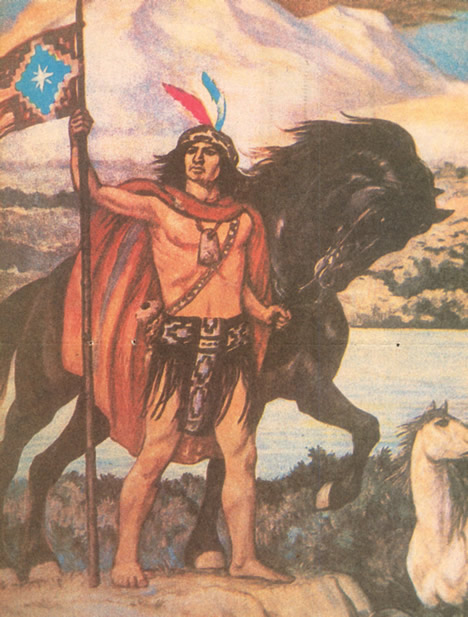 An attack
 19th century Mapuches fighting the Chilean army:
 Battle of quilacura (16th century). Mapuches combating Spaniards in equality of conditions.
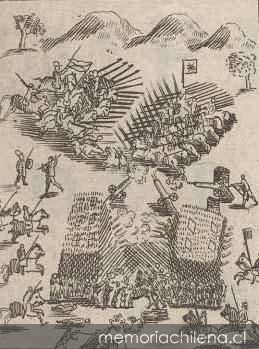 Lautaro
 Mapuche people today:
 A proud people
    That still today, fights for theirs rights with boleadoras
  And that call us, the rest of chileans, with a name we deserve, because the land was theirs: "huincas" (thieves)
Edited by pinguin - 08-Mar-2008 at 00:30 |
|
 |
|
Guests 
Guest 
|
 Quote Quote  Reply Reply
 Posted: 09-Mar-2008 at 16:19 Posted: 09-Mar-2008 at 16:19 |
|
Mustang, the Indian Horse
Of those mixtures, new breeds of horses appeared that become quite famous. Perhaps one of the best known are the Mustang. They are part of the legends of the United States and a horse that fought at the side of natives in many many battles.
    Mustangs are horses of extraordinary beauty, that deserve a post. I found some information to share with you on here.
History of the Mustang Horse:
When the Spanish explorers brought horses to the continent, the horses were returning home. When given the opportunity, the horses simply took up residence in the landscape their ancestors had helped to form. "Although the basis of legends, escaped horses from the early Spanish expeditions were not the seed stock of the wild horse herds of the American West. Only after the mission system in New Spain was established did horses begin to populate North America. Native groups, like the Apache, raided the missions for horses, and undoubtedly a few horses would have escaped. "The original horses brought to America from Spain were relatively unselected. These first came to the Caribbean islands, where populations were increased before export to the mainland. In the case of North America the most common source of horses was Mexico as even the populations in the southeastern USA were imported from Mexico rather than the Caribbean. The North American horses ultimately came from this somewhat non-selected base. However, only after the Pueblo Revolt of 1680 could large numbers of wild horses be seen roaming the grasslands of the Plains." (from "The Horse in the New World" exhibit at the Buffalo Bill Museum) (For an eye-witness account of the 1680 Pueblo Uprising, told by a missionary click HERE; For historical analysis, click here) "The Pueblo Revolt of 1680 was the single most successful act of resistance by Native Americans against a European invader. It established Indian independence in the pueblos for more than a decade, and even after Spanish domination was re-imposed it forced the imperial authorities to observe religious tolerance. " - http://www.americanjourneys.org/aj-009b/summary/index.asp The Revolt, in addition to driving the Spaniards from the Santa Fe-Albuquerque region for more than a decade, also provided the Pueblo Indians with three to five thousand horses. Almost immediately, they started breeding larger herds, with the intention of selling horses to the Apache and Comanche Indians. As a result, the widespread use of the horse revolutionized Indian life. While mounted Indians found that buffalo were much easier to kill, some tribes � such as the Comanche � met with great success when they used the horse for warfare.
|
|
 |
|
Guests 
Guest 
|
 Quote Quote  Reply Reply
 Posted: 14-Apr-2008 at 05:37 Posted: 14-Apr-2008 at 05:37 |
|
Jesus! Nobody else got interested in Amerindian cavalries?
|
|
 |
|
rider 
Tsar 
Suspended Joined: 09-Aug-2004 Online Status: Offline Posts: 4664 |
 Quote Quote  Reply Reply
 Posted: 14-Apr-2008 at 17:04 Posted: 14-Apr-2008 at 17:04 |
|
Hmmh. I'm more interested in the fact that they managed to develop cavalry forces so quickly and yet so well.
|
|
 |
|
Temujin 
King 
Sirdar Bahadur Joined: 02-Aug-2004 Location: Eurasia Online Status: Offline Posts: 5221 |
 Quote Quote  Reply Reply
 Posted: 14-Apr-2008 at 18:58 Posted: 14-Apr-2008 at 18:58 |
|
i missed this great thread until now!
 keep going, i'll try to participate later. keep going, i'll try to participate later.
|
|
 |
|
Guests 
Guest 
|
 Quote Quote  Reply Reply
 Posted: 15-Apr-2008 at 02:21 Posted: 15-Apr-2008 at 02:21 |
I don't know how North American or Brazilian Indians learned the skills. What I do know is how Mapuche Indians of Chile and Argentina acquired that knowledge.
The first battles between Mapuches and Spaniards were a disaster for the first. Without European tactics and disciplines, Spaniards killed them easily. In those rides, the Conquistador captured a teenager called Lautaro after killed his family. The conquistador adopted him as a helper and trainned him in the Spanish military arts. What a mistake!
The teenager, that have not forgiven Spaniards, wait some years to be well trainned and then escaped with his people, bringing all the Spanish military knowledge and horses. Since that moment things started to look pretty dark for Spaniards. In fact, Mapuches were never defeated by Spaniards, and they have to deal with them peace treaties.
|
|
 |
|
Darius of Parsa 
Colonel 

King of Kings Joined: 03-Oct-2007 Online Status: Offline Posts: 599 |
 Quote Quote  Reply Reply
 Posted: 15-Apr-2008 at 02:24 Posted: 15-Apr-2008 at 02:24 |
|
Quite an interesting story Pinguin.
|
|
|
What is the officer problem?
|
|
 |
|
rider 
Tsar 
Suspended Joined: 09-Aug-2004 Online Status: Offline Posts: 4664 |
 Quote Quote  Reply Reply
 Posted: 15-Apr-2008 at 18:29 Posted: 15-Apr-2008 at 18:29 |
|
Nice one there indeed.
I just meant that, if I'm correct, then the horse was unknown to the Americas before the Europeans came along. In just a few centuries however, the natives were very skilled in handling a horse... |
|
 |
|
Guests 
Guest 
|
 Quote Quote  Reply Reply
 Posted: 16-Apr-2008 at 04:22 Posted: 16-Apr-2008 at 04:22 |
The tragic part of it is that the horse appeared and evolved in the Americas. The horse migrated from the Americas to the Old World by the time humans arrived. The waves of new people exterminated several species in the Americas, in particular the horse. That animal was reintroduced by the Europeans 15.000 years after the extinction of theirs american cousins.
 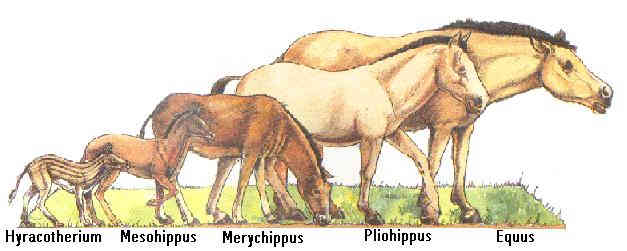 Genetic evidence is shedding new light on the origins of horses in the New World, during a particularly hazy period in their evolution.
As the Great Ice Age came to an end, some 11,000 years ago, North America was thought to be home to as many as 50 species and subspecies of horse. But studies of ancient DNA tell a rather different story, suggesting the horses belonged to just two species. These are the stilt-legged horses, now extinct, and the caballines. The caballines are thought to be the ancestors of today's domestic horse. "It looks like, as far as we can tell from the DNA, there is only evidence of two species in North America," Dr Alan Cooper from the University of Adelaide, Australia, told the BBC News website. "We think that, in fact, people have been looking at these fossils and over-interpreting signs of changes in shape and size," he added. "Probably these animals are adapting to local environments and perhaps they are [anatomically] more [changeable] than the palaeontologists had perhaps thought." Mitochondrial clock The work has implications for understanding other animals because horses are a textbook example of using fossil evidence to explain evolution. Although the horse fossil record is very rich, our picture of when and where different species arose is clouded. Analysis of mitochondrial DNA from fossilised bones, only possible in recent years, gives scientists a new tool to study evolution. In research published in the open access journal Plos Biology, Dr Cooper and colleagues at Oxford University, UK, analysed mitochondrial DNA from fossilised horse bones. Mitochondria, the powerpacks of the cell, have their own DNA and are inherited along the maternal line. Their DNA mutates at a stable rate, allowing researchers to look back in time at when different species diverged. Land bridge The Oxford research suggests that the stilt-legged horse, which was thought to have migrated into North America from Asia, at a time when the continents were linked by a land bridge, appears, in fact, to be native to North America. And the Patagonian Hippidion horse found in South America appears to be much younger than previously thought. It probably moved into South America about three million years ago, when the gap between North and South America closed up. This was a seminal period of evolution, when animals from the two continents were able to mix after a long period of isolation. |
|
 |
|
Temujin 
King 
Sirdar Bahadur Joined: 02-Aug-2004 Location: Eurasia Online Status: Offline Posts: 5221 |
 Quote Quote  Reply Reply
 Posted: 01-Jul-2008 at 20:29 Posted: 01-Jul-2008 at 20:29 |
|
do you have any literature recommendations on Guyakuru and Mapuche & Lautaro (in regards to mounted warfare)?
also, do Gauchos also fit in here? as i can see Mapuche used the Boleadora as well, or did the Gauchos copied from them? |
|
 |
|
Guests 
Guest 
|
 Quote Quote  Reply Reply
 Posted: 02-Jul-2008 at 00:12 Posted: 02-Jul-2008 at 00:12 |
Hi Temujin,
I am afraid I don't have more information on Guyakurus. However, on Mapuches there is lot.
Please visit these threads.
http://www.allempires.net/forum_posts.asp?TID=21871
http://www.allempires.net/forum_posts.asp?TID=21173 http://www.allempires.net/forum_posts.asp?TID=20775 The first is about bolas, the second is on cowboys, and the third about the Araucana, epic poem on which Lautaro is the hero. Lautaro was the Mapuche general that introduced horses to the Mapuches, changed its tactics and defeated Spaniards badly. So a Spanish soldier wrote a poem in honour of him and other Mapuches.
The first is the "balls" traditions, and how it passed from Pehuenches and Mapuches upon Gauchos. In a very real sense, Gauchos are descendents of the native Americans, either by blood or lifestyle. There are many Gauchos that are descendents of Amerindians, and all pride on the art of using boleadoras.
The Araucana is the single epic poem dedicated to an Amerindian people.
|
|
 |
|
Temujin 
King 
Sirdar Bahadur Joined: 02-Aug-2004 Location: Eurasia Online Status: Offline Posts: 5221 |
 Quote Quote  Reply Reply
 Posted: 02-Jul-2008 at 19:23 Posted: 02-Jul-2008 at 19:23 |
|
thanks, do you also know any books about mapuche?
|
|
 |
|
Guests 
Guest 
|
 Quote Quote  Reply Reply
 Posted: 03-Jul-2008 at 03:26 Posted: 03-Jul-2008 at 03:26 |
|
I am afraid I can't recommend books about the Mapuche in English. In Spanish there are tons, but I ignore the quality of the works in English. You can find the history of the Mapuche, written by them, in this site
And also from the university of Chile
And these are the pictures of an American tourist
You can find the Araucaniad in Amazon, although only in the used books section
Information about the War of Arauco, exist in the web. The wiki page is adecuate to start.
|
|
 |
|
Jalisco Lancer 
Sultan 
Retired AE Moderator Joined: 07-Aug-2004 Location: Mexico Online Status: Offline Posts: 2112 |
 Quote Quote  Reply Reply
 Posted: 03-Jul-2008 at 17:22 Posted: 03-Jul-2008 at 17:22 |
|
Mexican natives had the exposure to the horses during the conquest process.
At first, they were affraid of them. Later on, got familiarized with them. Became excelent raiders, problem was the spaniards alerted by this situation, decided to ban to the natives.under the penalty of death, to ride a horse. |
|
 |
|
tommy 
Colonel 
Joined: 13-Sep-2005 Location: Hong Kong Online Status: Offline Posts: 545 |
 Quote Quote  Reply Reply
 Posted: 14-Aug-2008 at 08:16 Posted: 14-Aug-2008 at 08:16 |
|
But i think the tribes of the eastern woodland did not ride horses much, if hteey had horses, they could bring a harder time to white, in the battle of the fallen timber, if they had horse, they might hold their position under the charge of general Wayne horse soldiers, it was Us horse soldiers, not the foot soldiers, broke the line of the native
|
|
|
leung
|
|
 |
|
xi_tujue 
Arch Duke 

Atabeg Joined: 19-May-2006 Location: Belgium Online Status: Offline Posts: 1919 |
 Quote Quote  Reply Reply
 Posted: 14-Aug-2008 at 13:12 Posted: 14-Aug-2008 at 13:12 |
But who thought them did they mimic the westerners? |
|
|
I rather be a nomadic barbarian than a sedentary savage
|
|
 |
|
Post Reply 
|
Page 12> |
| Forum Jump | Forum Permissions  You cannot post new topics in this forum You cannot reply to topics in this forum You cannot delete your posts in this forum You cannot edit your posts in this forum You cannot create polls in this forum You cannot vote in polls in this forum |
Copyright ©2001-2009 Web Wiz
This page was generated in 0.082 seconds.











 Printable Version
Printable Version Google
Google Delicious
Delicious Digg
Digg StumbleUpon
StumbleUpon Windows Live
Windows Live Yahoo Bookmarks
Yahoo Bookmarks reddit
reddit Facebook
Facebook MySpace
MySpace Newsvine
Newsvine Furl
Furl Topic Options
Topic Options

